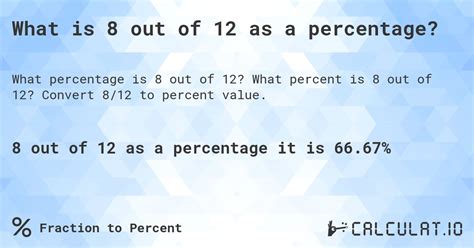What Is The Percent Of 8/12
Kalali
Apr 01, 2025 · 4 min read

Table of Contents
What is the Percent of 8/12? A Comprehensive Guide to Fractions, Decimals, and Percentages
Understanding fractions, decimals, and percentages is fundamental to various aspects of life, from everyday calculations to complex financial analyses. This comprehensive guide will delve into the process of converting the fraction 8/12 into a percentage, explaining the underlying principles and providing practical applications. We'll explore different methods to achieve this conversion and discuss the importance of mastering these fundamental mathematical concepts.
Understanding Fractions
A fraction represents a part of a whole. It consists of two parts: the numerator (the top number) and the denominator (the bottom number). The numerator indicates the number of parts you have, while the denominator indicates the total number of equal parts the whole is divided into. In the fraction 8/12, 8 is the numerator and 12 is the denominator. This means we have 8 parts out of a possible 12 equal parts.
Simplifying Fractions
Before converting a fraction to a percentage, it's often beneficial to simplify it. Simplifying a fraction means reducing it to its lowest terms by dividing both the numerator and the denominator by their greatest common divisor (GCD). The GCD of 8 and 12 is 4. Dividing both the numerator and denominator by 4, we get:
8 ÷ 4 = 2 12 ÷ 4 = 3
Therefore, 8/12 simplifies to 2/3. This simplified fraction represents the same value as 8/12 but is easier to work with in subsequent calculations.
Converting Fractions to Decimals
To convert a fraction to a percentage, we first need to convert it to a decimal. This is done by dividing the numerator by the denominator:
2 ÷ 3 ≈ 0.6667
Note that the division of 2 by 3 results in a repeating decimal (0.666...). We've rounded it to four decimal places for practical purposes. The more decimal places you use, the more accurate your final percentage will be.
Converting Decimals to Percentages
Converting a decimal to a percentage is straightforward. Simply multiply the decimal by 100 and add a percent sign (%):
0.6667 × 100 = 66.67%
Therefore, 8/12 is equal to approximately 66.67%.
Alternative Methods for Converting 8/12 to a Percentage
While the above method is the most common, there are alternative approaches:
Method 1: Converting to a Percentage Directly from the Simplified Fraction
We can also convert the simplified fraction 2/3 directly to a percentage:
(2 ÷ 3) × 100 ≈ 66.67%
Method 2: Using Proportions
We can set up a proportion to solve for the percentage:
8/12 = x/100
Cross-multiplying, we get:
12x = 800
Dividing both sides by 12:
x = 800 ÷ 12 ≈ 66.67
Therefore, x ≈ 66.67%, confirming our previous result.
Understanding the Significance of Percentages
Percentages are crucial for expressing proportions and making comparisons. They provide a standardized way to represent parts of a whole, making it easier to understand and interpret data. For instance, if a student scored 8 out of 12 on a quiz, knowing that this represents approximately 66.67% allows for easy comparison with other students' scores.
Practical Applications of Percentage Calculations
Percentage calculations are widely used across numerous fields, including:
- Finance: Calculating interest rates, discounts, tax rates, profit margins, and investment returns.
- Science: Expressing experimental results, analyzing data, and representing proportions in scientific studies.
- Business: Analyzing sales figures, calculating market share, and tracking key performance indicators (KPIs).
- Everyday Life: Calculating tips, discounts in stores, and understanding statistics presented in news reports.
Beyond 8/12: Mastering Fraction, Decimal, and Percentage Conversions
The methods outlined above can be applied to convert any fraction to a percentage. Mastering these conversions requires a solid understanding of fractions, decimals, and the relationship between them. Practice is key to improving proficiency in these calculations.
Examples:
- 1/4: 1 ÷ 4 = 0.25; 0.25 × 100 = 25%
- 3/5: 3 ÷ 5 = 0.6; 0.6 × 100 = 60%
- 5/8: 5 ÷ 8 = 0.625; 0.625 × 100 = 62.5%
By understanding the fundamental principles and practicing regularly, you can confidently convert fractions, decimals, and percentages, enhancing your problem-solving skills and making you more comfortable handling various quantitative scenarios.
Conclusion: The Power of Percentage Conversions
The conversion of 8/12 to a percentage, approximately 66.67%, highlights the importance of understanding the relationship between fractions, decimals, and percentages. These concepts are fundamental to various aspects of life, from everyday calculations to complex analytical tasks. By mastering these conversions, you equip yourself with valuable tools for interpreting data, making informed decisions, and succeeding in various academic and professional pursuits. Continue practicing to build your confidence and proficiency in these essential mathematical skills. Remember, the more you practice, the easier it becomes to navigate these crucial aspects of numerical literacy.
Latest Posts
Latest Posts
-
How Many Ounces In 1 2 Cup Sour Cream
Apr 02, 2025
-
Is The Pacific Ocean Colder Than The Atlantic
Apr 02, 2025
-
1 8 Of An Ounce In Grams
Apr 02, 2025
-
How Many Feet Are In 150 Inches
Apr 02, 2025
-
What Is 30 X 40 Cm In Inches
Apr 02, 2025
Related Post
Thank you for visiting our website which covers about What Is The Percent Of 8/12 . We hope the information provided has been useful to you. Feel free to contact us if you have any questions or need further assistance. See you next time and don't miss to bookmark.
